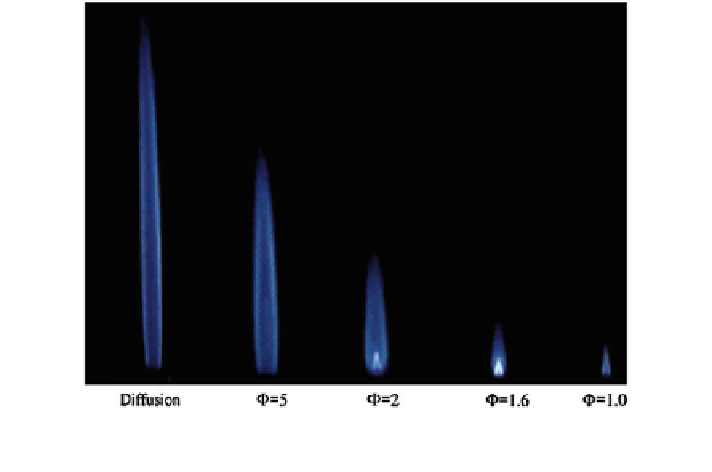Environmental Engineering Reference
In-Depth Information
Fig. 5 Images of laminar partially premixed 45 %H
2
/35 %CO/20 %CO
2
-air
fl
flames at different
levels of partial premixing. Reynolds number is 1,400
is increased from 1.0 to 1.6, then remains nearly constant for 1.6 <
<3.85, and
ϕ
subsequently decreases slowly as
is increased to the diffusion limit (
ϕ ⇒
∞
).
ϕ
Studies on turbulent syngas
fl
flames have focused on the determination of turbu-
lent
ame speeds (S
T
); (Daniele et al.
2011
; Venkateswaran et al.
2011
; Monteiro
et al.
2011
). Venkateswaran et al. (
2011
) reported measurements of global turbulent
fl
fl
flame speeds using a Bunsen burner and examined the effects of
, syngas com-
ϕ
position, mean
fl
flow velocity, and turbulence intensity. Consistent with other studies,
the
flame speed was found to exhibit sensitivity to fuel composition over a wide
range of turbulence intensity, increasing signi
fl
cantly with the increase in H
2
con-
tent. The data were further analyzed to develop
flame speed correlations, indicating
the effects of thermo-diffusive instabilities through negative Markstein lengths.
fl
3.2 Biogas Combustion and Emission Characteristics
There have been few studies focusing directly on biogas combustion. However, there
is a large body of literature on methane combustion, including ignition, extinction,
fl
flame speeds, cellular instabilities, and emissions. Consequently,
detailed thermo-transport and kinetic models have been developed to simulate and
analyze methane
flammability limits,
fl
gurations. Considerable research has also
been reported on the extinction and blowout of methane-air
fl
flames in a variety of con
flames using vari-
ous diluents, such as CO
2
,N
2
,H
2
O, and chemical agents (Linteris et al.
2008
;
Aggarwal
2009
). Most of these studies and the associated models can be readily used
for analyzing the combustion and emission characteristics of biogas, whose main
fl

Search WWH ::

Custom Search